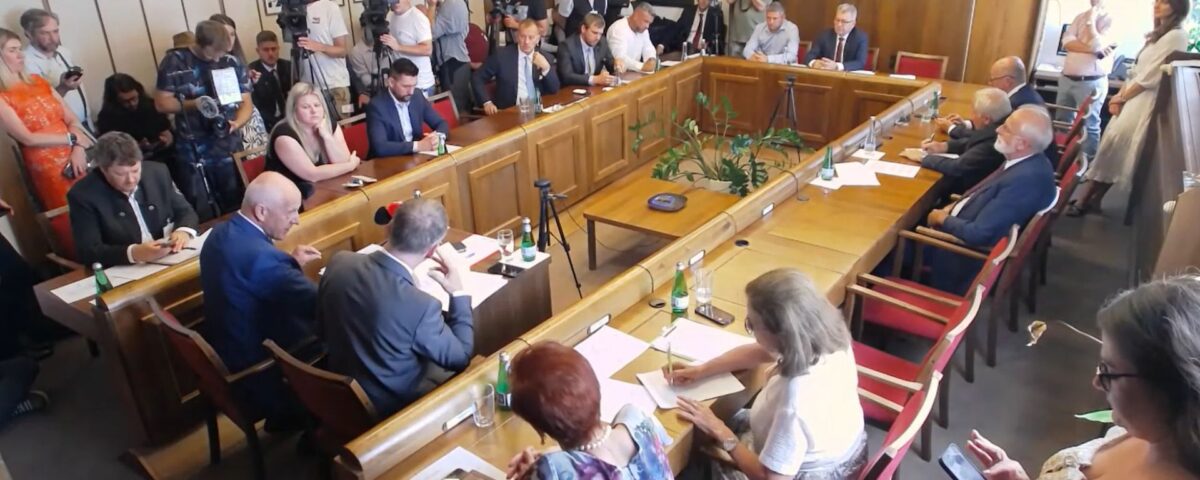MŽP SR: Proposal of Steps to Minimise the Risk of Human-Bear Encounters

The Ministry finds it important to take immediate action and does not want to rely on the negotiations ongoing at the European level.
The Ministry of the Environment of the SR is preparing a set of action, prevention and cooperation measures to address the brown bears issue. In relation to the plans to strengthen the conditions for the targeted brown bear control, the ministry is setting up an additional intervention team and initiating cooperation with the Ministry of the Interior of the SR on cooperation between the Police and State Conservancy officers in cases concerning problem bear specimens. The State Nature Conservancy is developing an app for reporting bear specimens and wants to create a platform for the cooperation between all relevant stakeholders, starting from state institutions, to farmers, conservationists, foresters and hunters. Last but not least, the Ministry would like to initiate an expedite usage of EU funds to support the preventive measures.
During today’s meeting of the Slovak National Council’s Committee for Agriculture and the Environment, Minister of the Environment Milan Chrenko spoke about the plans to strengthen the ability to act, prevention and cooperation in the field of brown bear management. He wants a see a set of quick measures implemented in the near future to minimise the risk of human-bear encounters in communities with a bear presence.
The set of measures includes preventive as well as proactive steps. The main pillar is to ensure cooperation between all stakeholders. “I consider it necessary to reiterate that bears do not belong in the built-up areas of municipalities. If a particular specimen repeatedly returns to residential areas, it is necessary to consider targeted regulation. Thus, in the case of a specimen that has lost its shyness, the last resort solution should be considered,” stated Minister Chrenko.
The measures are based on the first results of the brown bear population census, international experience and scientific studies both from Slovakia and abroad. The first thematic area is the strengthening of the capacity for action in brown bear related incidents through operational solutions implemented on the ground. According to the Ministry, it is essential to increase the staff capacity to ensure prompt intervention against specific problem bear specimens. Therefore, a new (fourth) team is currently being formed in the northern part of Slovakia under the auspices of the Tatra National Park.
“We see a lot of room for cooperation with the Slovak Police Force. The policemen are well trained and they have equipment for scaring off bears. We have initiated negotiations with the Ministry of the Interior of the SR in order to prepare a pilot project to be implemented in the Tatra National Park. If the concept proves feasible and effective, we will roll it out to other regions as well,” the Minister noted. If necessary, each intervention team would be supported by trained police officers, who can often arrive faster to the place of an incident.
The State Nature Conservancy is developing a mobile application called Medvede a ľudia (Bears and People), which can be used by members of the public to report the presence of a bear to the Brown Bear Intervention Team, and, for example, tourists will be able to get information about whether a bear has been reported in their immediate vicinity.
The second area is that of cooperation. The Ministry will re-establish a brown bear working platform and it also plans to revive and intensify the cooperation of all actors who can minimise the risk of human-bear encounters – from the Ministry of the Environment, the Ministry of Agriculture, the Ministry of the Interior, through the representatives of farmers, beekeepers, breeders, municipalities, hunters, foresters, conservationists and other relevant stakeholders.
“We can only set up well functioning preventive systems together, starting from the setting of criteria for fencing to reassessing the selection of crops grown in bear-endemic regions to setting up effective and predictable financial mechanisms to support prevention,” said Milan Chrenko.
The Minister also considers simplifying the system of compensation for farmers and animal breeders to be of key importance. The measure would not only concern bears. Farmers also face similar issues with cloven-hoofed game animals. According to the Minister, there should be a single simple mechanism for proving the damage incurred and seeking subsequent quick compensation.
The third – and most important – area remains preventing encounters. The Ministry of the Environment plans to strengthen research and monitoring. At the same time, however, it will propose and promote measures tailored to bear-bearing regions.
“When someone dumps an animal carcass, food, places bait or fails to secure a waste container near a local settlement, they attract bears to the areas inhabited by humans. They thus contribute to an increased risk of human-bear encounter and make the bear lose shyness. I would appeal to local authorities, municipal self-governments, to everyone really. It is our common task to point out this undesirable practice, to explain to the culprit the consequences of their actions and, if necessary, to hold them accountable, too,” said Minister Chrenko.
At the same time, the Ministry is initiating steps to allow for the launching of the call for funding for preventive measures from OP Slovakia as soon as possible.
The Ministry of the Environment is not opposed to negotiations on changes to EU legislation at the European level. However, the Ministry considers this procedure to be time-consuming and therefore prefers to take immediate measures in line with the current legislation.
This press release was prepared by the Ministry of the Environment of the Slovak Republic
